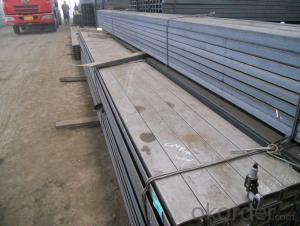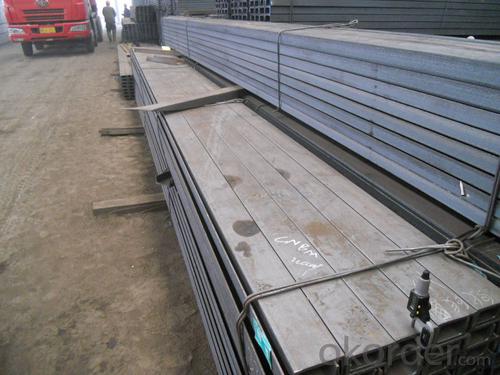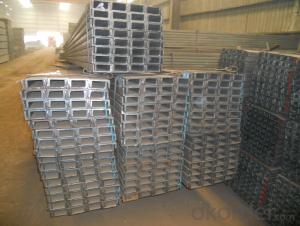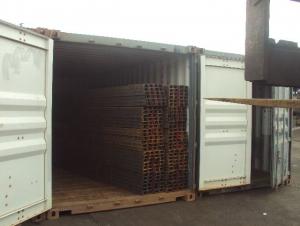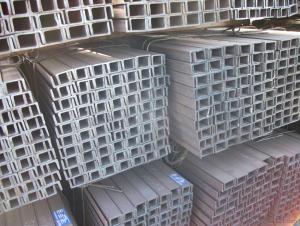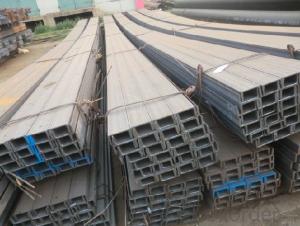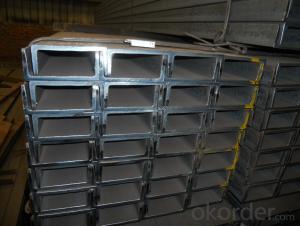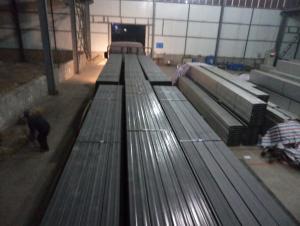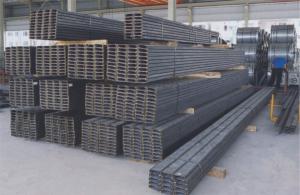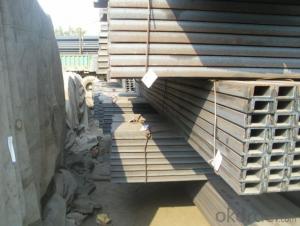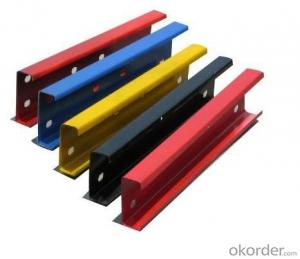Hot Rolled U-channel Carbon Steel JIS Standard High Quality
- Loading Port:
- Tianjin
- Payment Terms:
- TT or LC
- Min Order Qty:
- 25 m.t.
- Supply Capability:
- 1000 m.t./month
OKorder Service Pledge
OKorder Financial Service
You Might Also Like
Product Description:
OKorder is offering U-channel at great prices with worldwide shipping. Our supplier is a world-class manufacturer of steel, with our products utilized the world over. OKorder annually supplies products to European, North American and Asian markets. We provide quotations within 24 hours of receiving an inquiry and guarantee competitive prices.
Product Applications:
Channel Steel is usually used for building structure, vehicle manufacturing and other industrial structure and often used with i beam.
In details, the channel steel belongs to carbon structural steel which is applied to in the field of construction and machinery. The channel steel is usually used for arch-itechtural structure, and they could be welded in order to support or hang a vari-ety of facilities. They are also usually used in combination with I beam. Generally,the channel steel must possess perfect welding property, riveting property and mechanical property and so on.
Product Advantages:
OKorder's U-channel are durable, strong, and resist corrosion.
Main Product Features:
· Premium quality
· Prompt delivery & seaworthy packing (30 days after receiving deposit)
· Corrosion resistance
· Can be recycled and reused
· Mill test certification
· Professional Service
· Competitive pricing
Product Specifications:
1. We are definitely speciallizing in manufacturing and supplying channel steel as per japanese standard, which is characterised with high mechanical strength and competitive prices.
2. The sections in details are as followings in the table-1
JIS CHANNEL | Standard h | Sectional b | Dimension s | t | Mass: Kg/m |
(mm) | (mm) | (mm) | (mm) | ||
50x25 | 50 | 25 | 3.0 | 6.00 | 2.37 |
75X40 | 75 | 40 | 3.8 | 7.00 | 5.30 |
75X40 | 75 | 40 | 4.0 | 7.00 | 5.60 |
75X40 | 75 | 40 | 4.5 | 7.00 | 5.85 |
75X40 | 75 | 40 | 5.0 | 7.00 | 6.92 |
100X50 | 100 | 50 | 3.8 | 6.00 | 7.30 |
100X50 | 100 | 50 | 4.2 | 6.00 | 8.03 |
100X50 | 100 | 50 | 4.5 | 7.50 | 8.97 |
100X50 | 100 | 50 | 5.0 | 7.50 | 9.36 |
125X65 | 125 | 65 | 5.2 | 6.80 | 11.66 |
125X65 | 125 | 65 | 5.3 | 6.80 | 12.17 |
125X65 | 125 | 65 | 5.5 | 8.00 | 12.91 |
125X65 | 125 | 65 | 6.0 | 8.00 | 13.40 |
150x75 | 150 | 75 | 5.5 | 7.30 | 14.66 |
150x75 | 150 | 75 | 5.7 | 10.00 | 16.71 |
150x75 | 150 | 75 | 6.0 | 10.00 | 17.90 |
150x75 | 150 | 75 | 6.5 | 10.00 | 18.60 |
150x75 | 150 | 75 | 6.5 | 10.00 | 24.00 |
200X80 | 200 | 80 | 7.5 | 11.00 | 24.60 |
Note of U-channel
1. According to national standard (GB) for our products, if not, supply according to national standards (GB) or agreement.
2. We can not only provide electric furnace +LF+VD and electros lag re-melting (ESR) steel forging materials, but also forging products of piece, bar, etc.
3. Our company is equipped with roll equipment and can provide our customers with roll billets or finished.
4. The materials that we purchase are all accord with International General Standard; you could check it out on the Material Quality Sheet.
5. We are the creator of the “seven-step inspect method” in China.
FAQ:
Q1: Why buy Materials & Equipment from OKorder.com?
A1: All products offered byOKorder.com are carefully selected from China's most reliable manufacturing enterprises. Through its ISO certifications, OKorder.com adheres to the highest standards and a commitment to supply chain safety and customer satisfaction.
Q2: How do we guarantee the quality of our products?
A2: We have established an advanced quality management system which conducts strict quality tests at every step, from raw materials to the final product. At the same time, we provide extensive follow-up service assurances as required.
Q3: How soon can we receive the product after purchase?
A3: Within three days of placing an order, we will begin production. The specific shipping date is dependent upon international and government factors, but is typically 7 to 10 workdays.
Images:

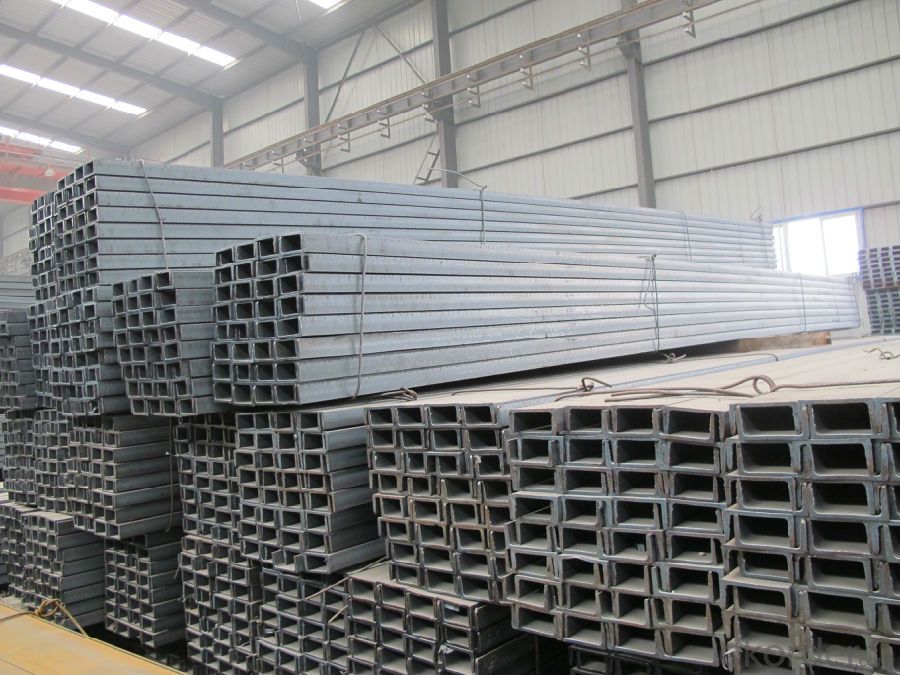
- Q: The pressure is: 50TLength: 1 meters or soMaterial: steel or steelSpecifications: please tell me how much you can use!Prawns help you ah! Urgent! Online, etc.!
- It should be counted like this. 50000/420/4/1=29.76. This is tensile strength, so it's enough to choose No. 20 i-beam.
- Q: Can steel channels be used in infrastructure projects?
- Yes, steel channels can be used in infrastructure projects. Steel channels are a versatile and commonly used structural component in construction and infrastructure projects. They are often used to provide support and stability to various structures, such as bridges, buildings, and highways. Steel channels offer several advantages that make them suitable for infrastructure projects. Firstly, they have high strength and durability, which makes them capable of withstanding heavy loads and extreme weather conditions. This ensures the long-term integrity and stability of the infrastructure. Additionally, steel channels can be easily fabricated and customized to meet specific project requirements. They are available in various sizes, shapes, and thicknesses, allowing engineers and architects to design and construct structures with precision. Furthermore, steel channels have excellent corrosion resistance properties. This is crucial in infrastructure projects, especially those exposed to moisture or harsh environmental conditions. Steel channels can be galvanized or coated with protective layers to prevent rust and corrosion, thereby extending their lifespan. Moreover, steel channels provide cost-efficiency. Compared to other construction materials, such as concrete or wood, steel channels have a longer lifespan and require less maintenance. This reduces the overall maintenance and replacement costs of infrastructure projects, making them a cost-effective choice. In conclusion, steel channels are widely used in infrastructure projects due to their strength, durability, customization options, corrosion resistance, and cost-efficiency. They play a crucial role in providing support and stability to various structures, making them a reliable choice for engineers and architects involved in infrastructure development.
- Q: What are the different methods for reinforcing steel channels?
- There are several methods for reinforcing steel channels, depending on the specific requirements and applications. Some of the common methods include: 1. Welding: Welding is a widely used method for reinforcing steel channels. It involves attaching additional steel plates or bars to the existing channel using high heat generated by an electric arc. This method provides a strong bond and ensures structural integrity. 2. Bolting: Bolting is another method used to reinforce steel channels. It involves attaching additional steel plates or bars to the channel using bolts and nuts. This method is relatively easier to implement and allows for easy removal or adjustment if required. 3. Adhesive bonding: Adhesive bonding is a technique that involves using industrial-grade adhesives to bond additional steel plates or bars to the steel channel. This method offers a strong bond and is often used in applications where welding or bolting may not be feasible or desired. 4. Fiber reinforced polymers (FRP): FRP composites, such as carbon fiber or fiberglass, can be used to reinforce steel channels. These materials are lightweight, high-strength, and corrosion-resistant, making them ideal for strengthening channels in corrosive environments or where weight is a concern. 5. Shotcreting: Shotcreting is a method that involves spraying a mixture of cement, sand, and reinforcing fibers onto the surface of the steel channel. This creates a layer of reinforced concrete that enhances the strength and durability of the channel. 6. Encasement: In some cases, steel channels may be reinforced by encasing them in concrete. This method involves pouring concrete around the channel, creating a composite structure that combines the strength of both materials. 7. Pre-stressing: Pre-stressing is a technique that involves applying tension to the steel channel before it is loaded. This can be done using pre-stressed steel strands or bars, which are anchored at the ends of the channel. The pre-stressing force helps to counteract the tensile forces that the channel may experience during use. It is important to note that the selection of the appropriate method for reinforcing steel channels depends on factors such as the load requirements, environmental conditions, cost, and feasibility. Consulting with a structural engineer or expert is recommended to ensure the chosen method meets the specific needs of the application.
- Q: The parameters of the channel steel of Q235B
- According to the GB/T 700-1988 GB standard, Q235B is carbon structural steel, and the grade is B,Chemical composition, mass fraction%|C:, 0.09 ~ 0.15Chemical composition, mass fraction%|Mn:, 0.25 ~ 0.55
- Q: Can steel channels be used in architectural facades?
- Yes, steel channels can be used in architectural facades. Steel channels offer structural stability, durability, and versatility, making them suitable for various architectural applications, including facades. They can be used to create visually appealing designs, provide support for cladding materials, and serve as a framework for architectural features such as windows or louvers.
- Q: How do steel channels perform in high-temperature industrial applications?
- The excellent performance capabilities of steel channels make them widely used in high-temperature industrial applications. Their high heat resistance is one of their key advantages in such environments. Steel is a highly durable and heat-resistant material, allowing it to withstand extreme temperatures without deformation or degradation. In high-temperature industrial applications, steel channels maintain their structural integrity even when constantly exposed to elevated temperatures. They can withstand thermal expansion and contraction without warping or bending, ensuring the stability and reliability of the structures they are used in. Additionally, steel channels exhibit excellent corrosion resistance, which is crucial in high-temperature environments where chemicals and gases may be present. This corrosion resistance prevents deterioration even when exposed to aggressive substances, ensuring their longevity and minimizing maintenance requirements. Moreover, steel channels possess high strength and load-bearing capacity, making them suitable for heavy-duty applications in industries such as manufacturing, construction, and oil and gas. Their robustness enables them to support heavy loads and withstand the demands of high-temperature environments without compromising their structural integrity. Furthermore, steel channels are versatile and easily customizable to meet specific requirements. They are available in various sizes, shapes, and thicknesses, allowing for greater flexibility in designing structures for high-temperature industrial applications. This adaptability makes steel channels the preferred choice for engineers and designers working in such industries. In conclusion, steel channels excel in high-temperature industrial applications due to their heat resistance, corrosion resistance, strength, and versatility. They provide reliable and durable components for structures exposed to extreme temperatures, ensuring the necessary stability and functionality for safe and efficient operations in high-temperature environments, whether it be in furnaces, boilers, or other industrial settings.
- Q: What are the load-bearing properties of steel channels?
- Steel channels have excellent load-bearing properties due to their structural design and material strength. They are capable of supporting heavy loads and distributing weight evenly, making them suitable for various applications such as construction, infrastructure, and manufacturing. Steel channels provide stability and durability, allowing them to withstand significant forces and maintain their structural integrity under pressure.
- Q: What is the difference between C steel, U steel and channel steel?
- U type steel (hot rolled U steel mine roadway Name: U steel) is English steel like the letter "U" with a cross section, sometimes with a cross section of Japanese letters "better" shape. Main features: large pressure, long support time, easy installation, not easy to deformation and so on. Main uses: mainly used in mine roadway, roadway support, and two times of the tunnel supporting etc.. As the main shape steel for the retractable metal support of tunnel, U steel is widely used at home and abroad.
- Q: Can steel channels be used for creating support structures for plumbing systems?
- Yes, steel channels can be used for creating support structures for plumbing systems. Steel channels provide strength and durability, making them suitable for supporting the weight of plumbing pipes and fixtures. They can be easily fabricated and installed, offering stability and longevity to plumbing systems.
- Q: What are the types of channel steels?
- Channel specification, model and theoretical weight table, channel steel is a strip of steel with a cross section. The representation of specifications, such as a*b*c (where a, B, C on behalf of the letters, no other meaning, and the relationship between letters), said waist height is a mm, B mm wide leg channel, channel waist thickness of C mm, or (a/10) # channel. The same height of the channel, if there are several different leg width and waist thickness, also need to add a, B, C on the right side of the model to distinguish, such as 25a#, 25b#, 25c# and so on.
Send your message to us
Hot Rolled U-channel Carbon Steel JIS Standard High Quality
- Loading Port:
- Tianjin
- Payment Terms:
- TT or LC
- Min Order Qty:
- 25 m.t.
- Supply Capability:
- 1000 m.t./month
OKorder Service Pledge
OKorder Financial Service
Similar products
Hot products
Hot Searches
Related keywords
